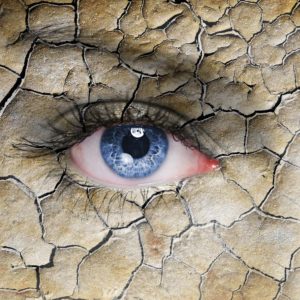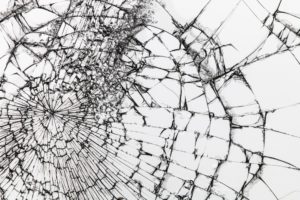
Many think of dry eye as simply being caused by not having enough tears. However, dry eye disease is generally much more complex than that. It is important to remember that what you feel does not always match what we as eye doctors see on the eye’s surface. For many patients, this can lead to confusion and frustration in the areas of diagnosis and treatment. Dry eyes can result in redness, irritation, and blurred vision.
To better understand the courses of treatment for dry eye, let’s look a some of the causes and solutions for dry eye disease (DED) or dry eye syndrome (DES). To frame the discussion, we can think of the corneal surface of the eye like the windshield of a car in the rain, and the wipers as the eyelids.
Dry Eye Causes and Solutions
Problem #1: Incomplete or Infrequent Blinking
 This is a situation where the wipers are either not wiping the whole windshield or they are not turned up enough. Our blink rate decreases with age, and can also decrease with certain diseases such as Parkinson’s Disease. Common visual tasks that require concentration such as reading, driving, watching TV, or using a computer are also frequent causes of dry eye symptoms from reduced or partial blinking.
This is a situation where the wipers are either not wiping the whole windshield or they are not turned up enough. Our blink rate decreases with age, and can also decrease with certain diseases such as Parkinson’s Disease. Common visual tasks that require concentration such as reading, driving, watching TV, or using a computer are also frequent causes of dry eye symptoms from reduced or partial blinking.
Available Solutions: Increasing blinking frequency, blinking more completely, use of artificial tears, patching the eyes closed occasionally, amniotic membranes, scleral contact lenses.
Problem #2: Sleeping with Eyes Partially Open

The wipers are broken. You may have seen a dog, cat, or another person who is asleep but still has their eyes cracked open slightly. The top of the cornea is clear, but the bottom open area of the eye can go for hours “without a wipe”. This can sometimes happen after eyelid surgery (blepharoplasty) to fix a droopy eyelid.
Available Solutions: artificial tear ointments at night that keep the eyes lubricated for a long time, patching at night, eyelid surgery
Problem #3: Conditions that Cause Tears to Evaporate too Quickly
 The wind is blowing the rain off the windshield. Fans, the dehydrated air in airplanes, vents, and dry geographic locations can all cause dry eyes.
The wind is blowing the rain off the windshield. Fans, the dehydrated air in airplanes, vents, and dry geographic locations can all cause dry eyes.
Available Solutions: Change location, stop or redirect the blowing air, humidify the air, use artificial tears, dry eye medications, scleral contact lenses
Problem #4: Poor Tear Quality
 The rain on the windshield beads up too fast. This leads to wet areas separated by dry areas. It is often caused by eyelid margin diseases such as meibomian gland disease (MGD), eyelid infection (blepharitis), and eyelid inflammation (ocular rosacea)
The rain on the windshield beads up too fast. This leads to wet areas separated by dry areas. It is often caused by eyelid margin diseases such as meibomian gland disease (MGD), eyelid infection (blepharitis), and eyelid inflammation (ocular rosacea)
Available Solutions: TearCare, artificial tears, eyelid hygiene, dry eye medications, steroid drops, medicated eyelid ointments, oral medications
Problem #5: Corneal Surface that is Not Smooth
 A corneal surface that is not smooth: Pits in the windshield prevent the rain from sheeting evenly. Scars, bumps, and valleys disrupt the tear film leading to dry areas.
A corneal surface that is not smooth: Pits in the windshield prevent the rain from sheeting evenly. Scars, bumps, and valleys disrupt the tear film leading to dry areas.
Available Solutions: thick artificial tears, scleral contacts, sometimes surgery
Problem #6: Medical Conditions that Reduce the Amount of Tears

Mist on the windshield without a hard rain can make the windshield streaky. Sjogren’s syndrome, other autoimmune conditions, and menopause can limit the number of tears being produced to lubricate the eye.
Available Solutions: treatment of the autoimmune condition, artificial tears, dry eye medications, steroid drops, amniotic membranes, scleral contact lenses
Problem #7: Medical Conditions that Cause Numbness of the Surface of the Eye

The wipers don’t detect the rain on the windshield and don’t turn on. Diabetes, herpes infections of the cornea and refractive surgery can lead to corneal numbness with decreased tear production.
Available Solutions: artificial tears, dry eye medications, patching, amniotic membranes, scleral contact lenses
Problem #8: Medications that Interfere with Making Tears
 Sandblasting of the windshield makes the surface rough. Glaucoma medications and the preservatives in many eye drops can damage the corneal surface.
Sandblasting of the windshield makes the surface rough. Glaucoma medications and the preservatives in many eye drops can damage the corneal surface.
Available Solutions: limit exposure to preservatives, avoid the use of eye drops that are not necessary, patching, amniotic membranes
This is not an all-inclusive list but gives an idea of the varied causes of dry eye disease. Many solutions need to be addressed simultaneously and even then, cures are rarely achieved. Instead, we look to control symptoms and limit ocular surface damage.
If you have dry eyes, please give my office a call at 713-668-6828 x2395 so we can help tailor a solution to help you see and feel better. I am dedicated to helping individuals in the greater Houston area find a solution for dry eye.


